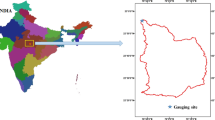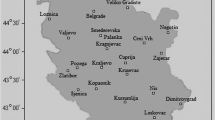Abstract
Past studies indicate that increasing temperatures would accelerate the Earth’s water cycle and in turn would increase the evaporation rate. Increased evaporation will result in more frequent and intense storms; hence, most researchers focus on climate change and its effect on Earth, particularly the precipitation. In the last two decades, the Udaipur district, India, faces water scarcity and flooding situations twice. The present study focuses on the prediction of rainfall using the most advanced soft computing techniques (SCT) such as multivariate adaptive regression splines (MARS), classification and regression trees (CART), and gene expression programming (GEP) in India’s Udaipur district. The performance of these SCT was evaluated to test the capability to predict the rainfall. Results showed that the MARS model for rainfall prediction showed better performance than the GEP model.
Similar content being viewed by others
Data availability
Upon request.
References
Azamathulla, H. Md. (2012). Gene expression programming for prediction of scour depth downstream of sills. Journal of Hydrology, 460–461C, pp. 169–172
Breiman, L., Friedman, J. H., Olshen, R. A., & Stone, C. J. (1984). Classification and regression trees. Wadsworth Statistical Press
Choubin, B., Malekian, A., & Golshan, M. (2016). Application of several data-driven techniques to predict a standardized precipitation index. Atmósfera, 29(2), 121–128
Choubin, B., Malekian, A., Samadi, S., Khalighi-Sigaroodi, S., & Sajedi-Hosseini, F. (2017). An ensemble forecast of semi-arid rainfall using large-scale climate predictors. Met. Apps, 24, 376–386. https://doi.org/10.1002/met.1635
Choubin, B., Zehtabian, G., Azareh, A., Rafiei-Sardooi, E., Sajedi-Hosseini, F., & Kişi, Ö. (2018). Precipitation forecasting using classification and regression trees (CART) model: A comparative study of different approaches. Environmental Earth Sciences, 77(8), 1–13
Delleur, J. W., & Kavvas, M. L. (1978). Stochastic models for monthly rainfall forecasting and synthetic generation. Journal of Applied Meteorology, 17(10), 1528–1536
Emamgolizadeh, S., Bateni, S. M., Shahsavani, D., Ashrafi, T., & Ghorbani, H. (2015). Estimation of soil cation exchange capacity using genetic expression programming (GEP) and multivariate adaptive regression splines (MARS). Journal of Hydrology, 529. Part, 3, 1590–1600
Ferreira, C. (2001a). Gene expression programming in problem solving, 6th Online World Conference on Soft Computing in Industrial Applications. (invited tutorial)
Ferreira, C. (2001b). Gene expression programming: A new adaptive algorithm for solving problems. Complex Syst, 13(2), 87–129
Friedman, J. H. (1991). Multivariate adaptive regression splines. Annals of Statistics, 19(1), 1–67
Guven, A., & Aytek, A. (2009). A new approach for stage-discharge relationship: Gene-expression programming. Journal of Hydrologic Engineering, 14(8), 812–820
Koza, J. R. (1992). Genetic programming: On the programming of computers by means of natural selection. MIT.
Mehr, A. D. (2018). Month ahead rainfall forecasting using gene expression programming. American Journal of Earth and Environmental Sciences, 1(2), 63–70
Mehta, D. & Yadav, S. (2020). Long-term trend analysis of climate variables for arid and semiarid regions of an Indian State Rajasthan. International Journal of Hydrology Science and Technology 1(1)
Pandhiani, S. M., Muhammed, S, Sihag, P., Singh, B. & Pham, Q. B. (2020). Time-series prediction of streamflows of Malaysian rivers using data-driven techniques, ASCE, Journal of Irrigation and Drainage, 146(7)
Parsaie, A., Haghiabi, A. H., Saneie, M., et al. (2018). Applications of soft computing techniques for prediction of energy dissipation on stepped spillways. Neural Computing and Applications, 29, 1393–1409
Perera, A., Mudannayake, S. D., Azamathulla, H. Md., & Rathnayake, U. (2020). Recent climatic trends in Trinidad and Tobago, West Indies. Asia-Pacific Journal of Science and Technology. (In Press)
Perera, A., Mudannayake S. D., Azamathulla H. Md., & Rathnayake, U. (2020). Recent climatic trends in Trinidad and Tobago, West Indies. Asia-Pacific Journal of Science and Technology, Thailand. (In Press)
Primary Census Abstract (PCA). (2011). District Census Handbook, Udaipur. Directorate of census operations Rajasthan, Census of India 2011. Series-09, Part XII-B
Rafiei-Sardooi, E., Mohseni-Saravi, M., Barkhori, S., Azareh, A., Choubin, B., & Jafari-Shalamzar, M. (2018). Drought modeling: A comparative study between time series and neuro-fuzzy approaches. Arabian Journal of Geosciences, 11(17), 1–9
Samadi, M., Afshar, M. H., Jabbari, E., & Sarkardeh, H. (2020a). Application of multivariate adaptive regression splines and classification and regression trees to estimate wave-induced scour depth around pile groups. Iranian Journal of Science and Technology, Transactions of Civil Engineering, 44(1), 447–459
Samadi, M., Afshar, M. H., Jabbari, E., & Sarkardeh, H. (2021a). Prediction of current-induced scour depth around pile groups using MARS, CART, and ANN approaches. Marine Georesources & Geotechnology, 39(5), 577–588
Samadi, M., Jabbari, E., & Azamathulla, H. M. (2014). Assessment of M5′ model tree and classification and regression trees for prediction of scour depth below free overfall spillways. Neural Computing and Applications, 24(2), 357–366
Samadi, M., Sarkardeh, H., & Jabbari, E. (2020b). Explicit data-driven models for prediction of pressure fluctuations occur during turbulent flows on sloping channels. Stochastic Environmental Research and Risk Assessment, 34(5), 691–707
Acknowledgements
The author wishes to thank Professor Hazi Md Azamathulla, University of the West Indies, St. Augustine Campus for his suggestions in preparation of this manuscript and review. The authors wish to acknowledge the extensive support of the Udaipur Meteorological Service in providing the climate data for this study.
Author information
Authors and Affiliations
Corresponding author
Ethics declarations
Conflict of interest
The authors declare no competing interests.
Research involving human participants and/or animals.
One author only.
Informed consent
Yes.
Additional information
Publisher's Note
Springer Nature remains neutral with regard to jurisdictional claims in published maps and institutional affiliations.
Rights and permissions
About this article
Cite this article
Chaplot, B. Prediction of rainfall time series using soft computing techniques. Environ Monit Assess 193, 721 (2021). https://doi.org/10.1007/s10661-021-09388-1
Received:
Accepted:
Published:
DOI: https://doi.org/10.1007/s10661-021-09388-1










